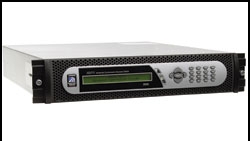Entertainment on demand

Operators need to carefully consider the various H.264 encoders available to ensure they fit with the network’s requirements. Scientific-Atlanta’s D9054 is an H.264 encoder that supports multiple applications, including IPTV, DVB-T and xDSL.
Internet Protocol Television (IPTV) is set to revolutionize the way we watch TV. IPTV's ability to provide video on demand (VoD) to consumers has been a key competitive differentiator. However, bandwidth has restricted its progress, until now. This article explains how H.264 (AVC or MPEG-4 Part 10) has given telecoms operators, who are vying for their share of the highly competitive market for entertainment video delivery, a new lease of life.
IPTV is set to raise interactive television to new heights. It's the on-demand platform that makes it an attractive proposition to consumers.
IPTV operators will need to enhance their offerings of home shopping, interactive programming, gaming and movies if they are to compete effectively with cable television (CATV) and satellite TV providers, who already provide similar services. Whilst telecoms operators have been quick to see the business potential IPTV had to offer, progress has been hampered by bandwidth constraints. H.264, a new encoding technology, is set to change all of this.
DSL and ADSL
Digital subscriber line (DSL) is used to deliver Internet services to most homes and businesses. It was originally intended for access to the Internet at faster speeds than traditional dial-up modems. However, DSL's limitations on network and distance made it difficult to deliver consistent high-speed data, a necessity for IPTV. A consumer needs to be in close proximity to a telephone company's central office (CO) to be able to receive data at rates of at least 6Mb/s to 8Mb/s, and data speed varies with distance. Most central offices use digital subscriber line access multiplexers (DSLAMs) to link customers to an asynchronous transfer mode (ATM) network. However, as speed over DSL lines increases, loop lengths had to be reduced, with DSLAMs being placed closer to the customer.
As demand for bandwidth increased, new technologies such as asymmetric digital subscriber line (ADSL) 2 and ADSL2 Plus were introduced, but bandwidth has not been sufficient for IPTV. To give an example, an SD channel requires around 3.5Mb/s. To compete in the video delivery market, a provider needs at least three premium channels of real-time viewing per household. For a basic broadcast, an operator needs at least 10Mb/s. Bandwidth plays a pivotal role for IPTV and its vast array of interrelated services. Therefore, the advanced encoders that use new compression technologies such as H.264 are likely to act as the catalyst for operators looking to introduce IPTV.
The professional video industry's #1 source for news, trends and product and tech information. Sign up below.
H.264 encoding
One of the main objectives of the H.264 standard was to provide a means to achieve higher video quality compared to what could be achieved using any of the existing video coding standards. The new encoding standard was also developed to be flexible so that it could be used within a variety of applications, for low and high bit rates and high and low video resolution.
Table 1. Compared with MPEG-2, H.264 is able to deliver up to 50 percent more compression efficiency. Click here to see an enlarged diagram.
H.264 is set to revolutionize the industry as it eases the bandwidth burden of delivery and opens the market for new services to be delivered to consumers. H.264 is able to deliver up to 50 percent more compression efficiency compared with MPEG-2, and it also helps ensure that picture quality is retained even at low bit rates such as 2Mb/s to 3Mb/s. (See Table 1 for a comparison of H.264 and MPEG-2.) This makes it one of the best solutions for widespread IPTV deployment.
Furthermore, H.264 enables the transmission of DVD-quality video over existing networks and nearly halves the bandwidth requirements for digital video delivery to around 2Mb/s. Another advantage of H.264 is its resilience to error, as the encoding standard provides the tools necessary to deal with packet loss in packet networks and bit errors in error-prone wireless networks.
Crucially, the new encoding standard gives telecoms operators the opportunity to offer an enhanced service and open the door to HD transmission, another key competitive differentiator in this highly competitive market. For xDSL networks, providing HD poses a challenge when providing more than one channel per home in addition to a simultaneous high-speed Internet connection, even when new technologies such as ADSL2 Plus are used. H.264 makes it possible to broadcast HD content over next-generation DSL networks.
New compression technologies may not make the IPTV offering any more competitive as both cable and satellite operators will look to offer similar services using the same technology. However, H.264 will help the telecoms provider compete on equal ground, which no doubt will include increased HD content and data services.
On the other hand, establishing the exact video quality is easier said that done. Some providers may use the MPEG-2 bit rates employed today to deduce the H.264 bit rate to give an equivalent quality. H.264 is often taken to have twice the efficiency of MPEG-2; hence, it needs 50 percent of the bandwidth. So a model can be created to plan program delivery to a subscriber. This is a risky strategy as the 50-percent benchmark is only an average, and H.264 is a completely new coding algorithm. This is not just an optimized version of MPEG-2. The percentage gain can vary by double- digit points in either direction for different video streams. Therefore, as a new system, further characterization of H.264 encoding over a wider statistical sample of video programming is required to establish the ideal bit rate. As the technology fully develops, it will see further gains in efficiency just as MPEG-2 did over the years.
CATV and broadcasting
CATV and IPTV share some common characteristics such as its use of IP to deliver VoD services to consumers. However, the similarity ends with the encoding standard used. CATV is able to use MPEG-2 over its existing infrastructure, which is able to transmit bit rates around 3Mb/s to 5Mb/s, appropriate for broadcast distribution. A CATV VoD signal transported from a server over the network needs to be converted into a stream that can travel via a coaxial cable in a modulated form, such as a QAM signal, and operators need to use reliable conditional-access infrastructure to encrypt the VoD streams.
On IPTV, the transmission of VoD is straightforward. Generally, the stream from the server is transmitted via the network directly into the household. IPTV's cell network structure, which has point-to-point links between a system and a subscriber, is a clear advantage to deliver the VoD unicast to a single consumer.
A CATV network, on the other hand, is more suitable for broadcast as a transmission seen by a number of households. Therefore, CATV operators need to make alterations on the network and to the software within the set-top to offer VoD services.
Similar to CATV, IPTV set-tops play a crucial role in the delivery of VoD content. Ultimately, it's the software within the set-tops that allow the consumer at home to order and watch on demand content. Not only should the set-tops be flexible in terms of formatting and content access, but also the necessary infrastructure should be in place to minimize the required bandwidth.
H.264 on demand
The battle to reach living rooms has never been greater, with CATV and satellite operators offering a whole range of services to consumers. Of course, the key differentiator is likely to be the quality of the transmission available on demand. Today, most people are not likely to accept anything less than DVD-quality pictures. One of the biggest challenges that service operators face is transmitting more content using less bandwidth and for less cost, while maintaining superior video quality. Using H.264 encoders as part of the IPTV network is set to revolutionize the way we watch TV.
Operators need to carefully consider the various H.264 encoders available to ensure they fit with the network's requirements, especially with services such as VoD. For example, some of the latest encoders are capable of cleaning up signals with noise and other artifacts so as to make the encoding more efficient. This improves picture quality at low bit rates, for both SD and HD.
The new compression standard has helped spawn the development of new applications, and this has provided service operators with new business opportunities.
Nick Fielibert is Scientific-Atlanta's vice president, chief technology officer and chief architect for Europe and Asia.
